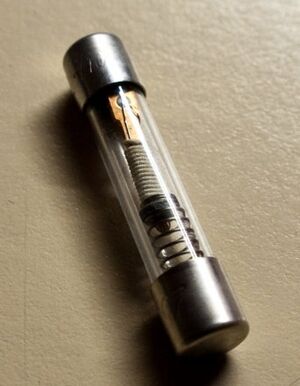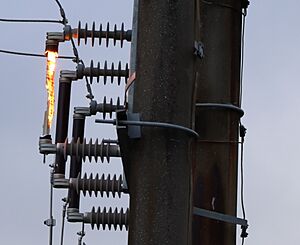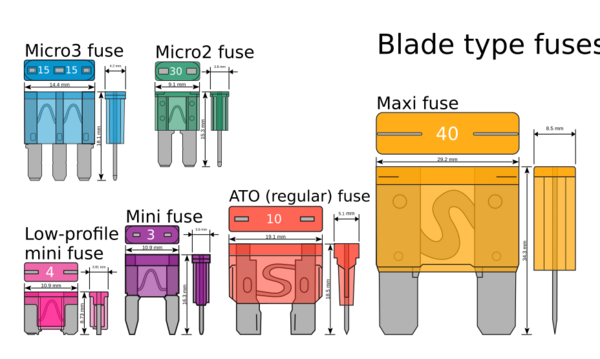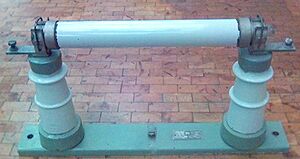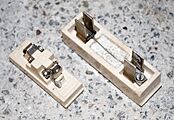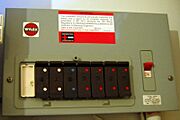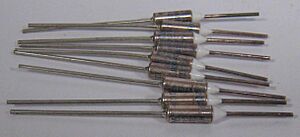Fuse facts for kids
A fuse is a safety device used in electronics and electrical engineering. Its main job is to protect electrical circuits from too much electric current. Imagine a tiny metal wire or strip inside the fuse. If too much current flows through it, this metal part gets hot and melts. When it melts, it breaks the circuit, stopping the electricity.
Fuses are like a sacrifice for your electronics. Once a fuse melts, it's broken and can't be used again. You have to replace it with a new one. Fuses have been important safety tools since electricity was first used. Today, there are many types of fuses. They come in different sizes for various amounts of current and voltage. This helps them protect different devices without stopping the power for no reason. Fuses help prevent damage from short circuits, too much power, or broken devices.
Fuses are a way to automatically turn off power to a faulty system. While Circuit breakers are used more often now, fuses are still important. They are used when space, reliability, or cost are key factors.
Contents
- History of Fuses
- How Fuses Are Built
- Fuse Characteristics
- Voltage Drop
- Temperature Derating
- Fuse Markings
- Fuse Packages and Materials
- Dimensions
- Fuse Standards
- Automotive Fuses
- High Voltage Fuses
- Fuses vs. Circuit Breakers
- Fuse Boxes
- Coordination of Fuses in Series
- Other Circuit Protectors
- Unicode Symbol
- See also
History of Fuses
People started using special wires to protect telegraph stations from lightning strikes as early as 1864. These smaller wires would melt and protect the equipment inside.
Later, in 1890, Thomas Edison patented a fuse. It was part of his system for distributing electricity.
How Fuses Are Built
A fuse has a small metal strip or wire inside. This part is called the fuse element. It's much smaller than the other wires in the circuit. This element is connected between two electrical terminals. Usually, it's covered by a case that won't burn.
The fuse is placed in series with the circuit it protects. This means all the electricity for that circuit flows through the fuse. When current flows, the fuse element gets warm. It's designed so that normal current doesn't make it too hot. But if too much current flows, the element gets much hotter. It then melts, or it melts a special soldered joint inside. This breaks the circuit and stops the power.
Fuse elements are made from metals like zinc, copper, silver, or aluminum. These materials help the fuse work reliably. A good fuse should carry its normal current forever. But it should melt quickly if there's a small surge of extra current. The element also needs to resist damage from small, harmless power spikes. It should not change over time, even after years of use.
Sometimes, fuse elements are shaped in special ways to increase heating. In large fuses, the current might be split among several metal strips. Some fuses have two elements. One melts instantly for a short circuit. The other is a low-melting solder joint that reacts to smaller, long-term overloads. Fuse elements can also be supported by strong wires to prevent strain. Some fuses even have a spring to make the melting process faster.
The fuse element can be surrounded by air. Or it might be surrounded by materials like Silica sand. These materials help to quickly stop the electric arc that forms when the fuse melts.
Fuse Characteristics
Fuses have different features that describe how they work.
Rated Current (IN)
This is the maximum amount of current a fuse can carry all the time. It won't break the circuit if the current stays at or below this level.
Time vs. Current Characteristics
How fast a fuse melts depends on two things. It depends on how much current flows through it. It also depends on what the fuse is made of. Manufacturers provide charts that show how long a fuse takes to blow at different current levels.
The time it takes for a fuse to blow gets shorter as the current increases. Fuses are designed to have specific timing. A standard fuse might need twice its rated current to open in one second. A "fast-blow" fuse might open in 0.1 seconds with the same current. A "slow-blow" or "time-delay" fuse might take tens of seconds to blow.
Choosing the right fuse depends on the device it's protecting. For example, sensitive electronic parts might use a "fast" or "ultrafast" fuse. These parts heat up very quickly with too much current. Fast-blow fuses are good for general use. "Time-delay" fuses are used for things like motors. Motors can draw a lot of current for a few seconds when they start up. A time-delay fuse lets this happen without blowing.
Breaking Capacity
The breaking capacity is the highest current a fuse can safely stop. This value should be higher than any possible short-circuit current. Small fuses might only interrupt 10 times their rated current. Fuses for homes in North America are often rated to stop 10,000 amperes. Fuses for industrial systems can stop much higher currents, sometimes up to 300,000 amperes.
Some fuses are called "high rupture capacity" (HRC) or "high breaking capacity" (HBC). These fuses are usually filled with sand or a similar material.
HRC fuses are used in places where very high short-circuit currents can happen. This includes main power boards in buildings or transformer stations. They are generally larger than screw-type fuses. In some countries, only trained people are allowed to change these fuses.
Rated Voltage
The voltage rating of a fuse must be equal to or higher than the voltage of the circuit. For example, a fuse rated for 32 volts won't work safely on a 120-volt circuit. If a low-voltage fuse tries to stop a high-voltage current, an arc might form. This arc could keep the current flowing, even after the fuse element melts. The rated voltage should always be higher than the maximum voltage it might need to disconnect.
Voltage Drop
Manufacturers might tell you the voltage drop across a fuse. This is how much voltage is lost when current flows through the fuse. This is important for low-voltage devices. As current flows, the fuse heats up, and its resistance and voltage drop increase.
Temperature Derating
The temperature around a fuse affects how it works. A fuse rated for 1 amp at 25°C might carry more current in very cold temperatures. It might also blow at less than its rated value in very hot temperatures. These changes are listed in the manufacturer's data sheets.
Fuse Markings
Most fuses have markings on their body or ends. These markings tell you important information about the fuse. Small "chip type" fuses for surface mounting might have very few markings, making them hard to identify.
Fuses that look similar can have very different properties. Their markings help you tell them apart. Fuse markings usually show:
- The current rating (how much current it can handle).
- The voltage rating.
- How fast the fuse blows (its time-current characteristic).
- Approvals from safety organizations.
- The manufacturer's name or part number.
- The interrupting rating (how much current it can safely stop).
Fuse Packages and Materials
Fuses come in many shapes and sizes for different uses. They are made in standard sizes so they can be easily swapped. Fuse bodies can be made of ceramic, glass, plastic, or fiberglass. The material depends on where and how the fuse will be used.
"Cartridge" fuses are cylinder-shaped with metal caps on the ends. Some cartridge fuses have caps of different sizes. This stops you from accidentally putting the wrong fuse into a holder.
Fuses for low-voltage power might have metal blades or tags. These are bolted or clipped into a fuse holder. Blade-type fuses often need a special tool to remove them.
"Renewable fuses" have parts that can be replaced. This means you can reuse the main fuse body if it's not damaged.
Fuses for printed circuit boards have wire leads for soldering. "Surface mount" fuses have flat pads instead of leads.
High-voltage fuses are often open at one end. They have tubes made of fiber or plastic. Their fuse element can be replaced.
"Semi-enclosed fuses" let you replace the fuse wire itself. However, it's very important to use the correct wire size and material. Because of this, these fuses are becoming less common.
Glass fuses let you see if the element has melted. But they have a low breaking capacity. This limits them to circuits of 15 amps or less at 250 volts. Ceramic fuses have a higher breaking capacity. They are used in circuits with more current and voltage. Filling a fuse with sand helps cool the arc and increases its breaking capacity.
Some fuse packages have a special feature to prevent wrong fuses from being used. For example, a pin or slot might stop a fuse with a lower breaking capacity from being installed where a higher one is needed.
Dimensions
Fuses are made in different sizes to prevent people from using the wrong rating. For example, "bottle style" fuses have different cap diameters for different ratings. Old car glass fuses were made in different lengths. This stopped higher-rated fuses from being put into circuits meant for lower ratings.
Special Features
Glass fuses let you see if the wire has melted. Other fuses have different ways to show they've blown:
- Indicating pin: A small pin pops out of the fuse cap when it blows.
- Indicating disc: A colored disc on the end cap falls out when the fuse blows.
- Element window: A small window in the fuse body lets you see the blown element.
- External trip indicator: This is like a striker pin but can be attached to a compatible fuse.
Some fuses for medium-voltage use have two or three separate barrels. They also have two or three fuse elements working together.
Fuse Standards
Different organizations set standards for fuses. This helps make sure fuses are safe and work correctly.
IEC 60269 Fuses
The International Electrotechnical Commission (IEC) has a standard called 60269 for low-voltage power fuses. This standard helps make fuses interchangeable around the world. Fuses that meet IEC standards will have similar time-current characteristics. This makes them easier to design with and maintain.
UL 248 Fuses (North America)
In the United States and Canada, low-voltage fuses follow the Underwriters Laboratories (UL) standard UL 248. This standard covers fuses up to 1,000 volts AC or DC. It includes fuses with a breaking capacity up to 200,000 amps. These fuses are for electrical systems that follow the Canadian Electrical Code or the National Electrical Code.
Standard current ratings for fuses in North America include 15, 20, 30, 50, 100, and up to 6000 amperes.
The IEC and UL standards use slightly different words. IEC calls the whole device a "fuse." In North America, the "fuse" is the part you replace.
Automotive Fuses
Automotive fuses protect the wiring and electrical parts in vehicles. There are several types, depending on the car's electrical system. Automotive fuses can be put in fuse blocks or special holders. Some car fuses are also used in other electrical devices.
Automotive fuses fall into four main groups:
- Blade fuses
- Glass tube or Bosch type
- Fusible links
- Fuse limiters
Most car fuses are rated at 32 volts. They are used in circuits that are 24 volts DC or less. Some vehicles use a 42-volt system, which needs a 58-volt DC fuse.
High Voltage Fuses
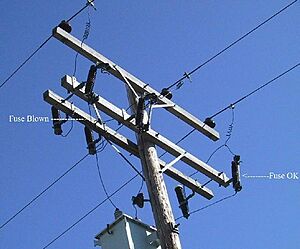
Fuses are even used in large power systems up to 115,000 volts AC. High-voltage fuses protect things like transformers used for measuring electricity. They are also used for smaller power transformers where a circuit breaker would be too expensive. A circuit breaker at 115 kV can cost five times more than a set of fuses.
In medium-voltage power systems, a fuse might protect a transformer that serves a few houses. Transformers on power poles often have a fusible cutout. This allows the fuse element to be replaced using special tools while the power lines are still active.
Medium-voltage fuses also protect motors, capacitor banks, and transformers. They can be found in metal switchgear.
Expulsion Fuses
Large power fuses use elements made of silver, copper, or tin. These materials give them stable performance. High-voltage expulsion fuses surround the fuse link with materials that create gas, like boric acid. When the fuse blows, the heat from the electric arc makes the boric acid produce a lot of gas. This high pressure and cooling gas quickly stop the arc. The hot gases then shoot out of the fuse ends. These fuses can only be used outdoors.
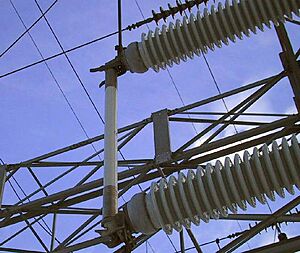
Some of these fuses have a pin that can activate a switch. This way, if one fuse blows, all three phases of power are turned off.
"High-power fuses" can stop many thousands of amperes of current. Some can stop up to 63,000 amps in a short circuit.
Fuses vs. Circuit Breakers
Fuses often cost less and are simpler than circuit breakers for similar power levels. When a fuse blows, you have to replace it. This is less convenient than just resetting a breaker. This might make people less likely to ignore electrical problems. However, replacing a fuse without turning off the power first can be dangerous.
Fuses usually stop faults faster than circuit breakers. A fuse can clear a fault in less than a quarter of a power cycle. A circuit breaker might take half to one cycle. A fuse can react as fast as 0.002 seconds. A circuit breaker usually takes 0.02 to 0.05 seconds.
High rupturing capacity fuses can safely stop up to 300,000 amps at 600 volts AC. Special "current-limiting" fuses work so fast that they limit the total energy that flows into the circuit. This helps protect equipment further down the line. Circuit breakers cannot match this speed.
Some circuit breakers need regular maintenance to make sure they work. Fuses don't need this because they rely on melting, not mechanical parts.
In a multi-phase power circuit, if only one fuse blows, the other phases might get too much current. This can cause unbalanced voltages and damage motors. Fuses only detect too much current or heat. They usually can't be used with advanced protection systems, like those that detect ground faults.
For homes, Miniature circuit breakers (MCB) are often used instead of fuses. They come in different current ratings like 6A, 10A, 16A, and up to 125A.
Fuse Boxes
United Kingdom
In the UK, older electrical boxes (called consumer units) used either "rewirable" fuses or cartridge fuses. Rewirable fuses let you replace the fuse wire itself. (Fuse wire is sold in short lengths, like 5-amp or 15-amp wire.) Modern consumer units usually have miniature circuit breakers (MCBs) instead of fuses.
- UK fuse boxes and rewirable fuses
Rewirable fuses can be dangerous if someone puts in a fuse with too high a rating. Or they might use copper wire or even a coin instead of the correct fuse wire. This removes the safety protection and can be very dangerous. You can't see this tampering without fully checking the fuse.
North America
In North America, fuses were used in buildings wired before 1960. These "Edison base" fuses screwed into a socket, like light bulbs. They came in ratings like 5, 10, 15, 20, and 30 amperes. To stop people from using fuses with too high a current rating, newer fuse boxes have special "rejection features." These are called "Rejection Base (Type S fuses)." They have smaller diameters that change with the fuse rating. This means you can only replace a fuse with the correct Type S fuse. You can convert older Edison fuse boxes to accept Type S fuses by screwing in a special adapter.
Some companies make resettable miniature thermal circuit breakers that screw into a fuse socket. However, if the fuse box door holds down the breaker's reset button, the breaker won't provide protection.
By the 1950s, circuit breakers mostly replaced fuses for protecting circuits in new homes and factories.
Fuses are still widely used to protect electric motors. For small overloads, the motor's own protection system will turn it off. The fuse only blows for short circuits or very large overloads.
Coordination of Fuses in Series
Sometimes, several fuses are connected one after another in a power system. It's best if only the fuse closest to the problem blows. This is called "coordination." It means the smaller fuse near the problem should blow much faster than the larger fuse supplying it. This way, only the faulty part of the circuit is turned off. Other circuits connected to the same main fuse keep working.
Other Circuit Protectors
Resettable Fuses
"Self-resetting fuses" use a special material called a polymeric positive temperature coefficient (PPTC) thermistor. This material increases its resistance when too much current flows. This stops the circuit. When the current is removed, the device cools down and goes back to its low resistance. These are often used in places where replacing a fuse is hard, like in aerospace. They are also used on computer motherboards to protect against shorted keyboards or mice.
Thermal Fuses
A thermal fuse is found in things like coffee makers or hair dryers. It has a special material that melts when the temperature gets too high. When it melts, a spring mechanism opens the circuit. For example, it can stop a hair dryer from catching fire if the airflow is blocked. Thermal fuses are "one-shot" devices. Once they blow, they must be replaced.
Cable Limiter
A cable limiter is like a fuse but only protects low-voltage power cables. It's used when multiple cables are connected side-by-side. It doesn't protect against small overloads. Instead, it protects a cable if there's a short circuit. The limiter is matched to the cable size. It blows before the cable's insulation gets damaged.
Unicode Symbol
The symbol for a fuse in computer text is U+23DB (⏛).
See also
 In Spanish: Fuse para niños
In Spanish: Fuse para niños
- Antifuse
- Circuit breaker
- Power system protection
- Programmable ROM
- Recloser
- Shunt (electrical)
- Bead (electrical)
- Zero-ohm link


